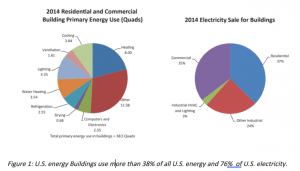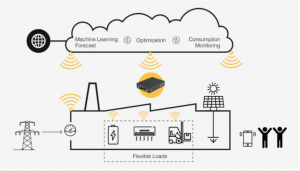The problem: energy reduction in commercial and industrial buildings
The energy consumption of buildings accounts for a significant share of total energy consumption in developed countries, and it has increased significantly in the last years: we spend more time indoors, require more floor space, use more electric appliances and have stricter regulations on for example air quality indoors. In the United States, buildings account for more than one-third of all energy use and more than three-quarters of electricity use. Within this segment, heating, lighting and cooling use the most energy; residential buildings account for 37% of energy sale, whereas commercial and industrial buildings account for the rest (figure 1). The International Energy Agency estimates that buildings could become up to 40% more efficient than they are today.
What is holding us back? For residential buildings, it is most likely the substantial investment combined with habit: we need to insulate our walls, install double-glazed windows, and remind ourselves to turn off the heating or A/C when we leave our house. For commercial and industrial buildings, the reasons are similar but more complicated. Large commercial and industrial buildings require major capital investments to make them more energy efficient; for example, insulating walls and windows, installing heat pumps or solar panels, upgrading the HVAC system or replacing all lights with LED.
Also, commercial and industrial buildings require more sophisticated systems to manage energy consumption than residential buildings: you cannot ask your employees to turn off the heating every time they leave the room. This requires investments in often costly energy management systems. Energy efficiency is also often associated with lower comfort (turning off the heating or the A/C), or with inhibiting production efficiency. Imagine a production hall with large doors to allow trucks to deliver goods. From an energy efficiency standpoint, you might want to close the doors as soon as possible, but this might be very inconvenient for the supply chain.
Now that heat pumps and solar panels are becoming cost efficient, more companies might be willing to make investments to reduce the energy consumption in their buildings. Moreover, the rise of the Internet of Things in combination with cloud computing is creating possibilities to employ smarter and more cost-efficient energy management systems to reduce energy use. However, these technologies are still mostly in the development phase and have not been widely adopted.

BeeBryte offers a cloud-based Software-as-a-Service that controls in real-time both batteries (that are installed in the buildings) and existing heating/cooling equipment to benefit from the cheapest tariff and deliver up to 40% utility bill savings. The technology combines proprietary trading algorithms, cloud computing, and predictive analytics to offer dynamic energy optimization services fully integrated into the Internet of Things (IoT).


BeeBryte’s Energy Intelligence solution optimises energy consumption by maximising self-consumption from onsite generation, capturing electricity price arbitrage opportunities, reducing network charges (peak-shaving) and bringing services to the grid.
What does it mean for electricity retailers? Electricity retailers can generate new revenues using customers’ flexibility to buy energy at the lowest price and to sell new grid services. This opens an opportunity to engage and retain their customers by sharing a portion of these savings through discounted rate plans.
The Business Model
The company operates on a “Shared Savings Model”. This means that their compensation depends on how much the customer is saving compared to the pre-implementation system.
BeeBryte focuses on the servitization of the traditional energy-saving industry product. For the system to run, no replacement or installation of new equipment is required. An IoT box and sensors are put in place in strategic parts of the plant and the building, with an initial investment of few thousands of Euros, that the company usually installs free of charge.
The technology developed allows the customer to save up to 40% from its electricity bill, from which BeeBryte keeps a cut of around 60% – 40%. The percentage depends on whether Beebryte installs the sensors and the IoT box free of charge or the customers pays for it. In the first case, they will compensate for the first investment by charging a higher percentage (usually 60%) for the first period, and then adjust it back to 40%.
For the first two months, the technology doesn’t manage the system but gathers information and builds the prediction model. The sensors capture data that influence the change in temperature in the target area (e.g. number of people in the building, when they enter and for how long, how many times the door is open and in which part of the day, when other equipments are usually turned on /off, delivery schedule, etc), and combines it with any external relevant data (e.g. weather, exposition, season, etc). The patented AI-based algorithm embedded in the system builds a prediction model on the behaviour observed. This model, combined with predictive analytics on energy prices volatility and weather forecasts, starts then to automatically manage the system, turning on and off the different part of the HVAC plan to keep the temperature between certain pre-defined thresholds.
During the first year, the system shut down for a couple of weeks every three months. During this period, it runs a “calibration/validation” and assesses the baseline over which the company calculate the savings. This part is essential since the change of seasons plays an important role in the heating/chilling needs of the building. After one entire year that the technology is up and running, the calibration is made any time that the customer requires.
The customer achieves the double objective of cutting energy costs and lowering the carbon footprint of the facility, by consistently managing its carbon emissions.
BeeBryte has grown around the sustainable development goals, especially Goal 7 (“Clean and affordable energy), 9 (“Build resilient infrastructure, promote sustainable industrialization and foster innovation”) and 12 (“Responsible production and consumption”):

Specially, BeeBryte addresses Goal number 9: “By 2030, upgrade infrastructure and retrofit industries to make them sustainable, with increased resource-use efficiency and greater adoption of clean and environmentally sound technologies and industrial processes, with all countries taking action following their respective capabilities.”
BeeBryte contributes directly to indicator 9.4.1: CO2 emission per unit of value added. Their energy management system helps clients to reduce the energy consumption of commercial and industrial buildings and upgrades the buildings to make them smarter in energy consumptions. Clients are, therefore, able to lower their (indirect) CO2 emissions proportionally. In addition, BeeBryte helps clients to maximize self-consumption of electricity and thus promotes the use of solar panels as clean technology. Their energy management system is very flexible and can be applied to a wide variety of buildings and industries and can thus help to promote sustainable industrialization.
Traditional competitors in the energy efficiency market usually work on a different business model: after running an audit to assess the status quo in terms of constructional features of the building and existing technologies, they follow-up with a project that needs to be implemented. The new project usually focuses on technology and structural improvement in the buildings, such as new equipment, lamps, batteries, insulation, etc. These methods have the barrier at the entry of the magnitude of the initial investment. This is the reason why often these companies provide also financing options to cover the initial costs.
What’s innovative about BeeBryte’s solution is our capacity to predict and anticipate (thanks to AI and our patented real-time optimization algorithms). By anticipating changes in weather conditions, building occupancy, business activity… our solution continually adjusts the setpoints not only to run the process in a more efficient way (energy efficiency gains) but also to extract additional value like power peak shaving (reducing penalties due to uncontracted capacity) and price arbitrage if our customer is exposed to variable electricity rates.
Further Expansion Risks and Scalability
While any business model that builds on a proprietary software model that can at least partly be re-used for subsequent clients, is in potential very suitable for scaling there are also risks to effectively building out the model. Arguably, the very first part of this business is the hardest: getting proof-of-concept and a few well-known brands to be first-movers and promoters. Then, increasing in size will allow for economies of scale in the procurement of physical requirements, such as the required sensors and electricians and installation technicians. The software is an artificial-intelligence powered self-learning system and should therefore, in theory, require very little manual adjustments before being applied at other clients. However, one could argue that the proof of the pudding is in the eating here and that it would perhaps be a too optimistic assumption to expect the software to optimize fully independently. As anyone who ever struggled writing code will recognize, algorithmic thinking can sometimes lead to models stumbling over just a small piece of wholly new information.
In this case, every building will have its own variables and technical issues, from different building styles, forms of insulation and exposition to sun and wind, potentially requiring other and differently placed sensors. When building this out, the extent to which this (evil) variability occurs will largely determine whether the unit economics will continue to work out. While Singapore is relatively stable in terms of climate, scaling up to different geographies can present an additional challenge in introducing different climates and weather types to the model.
In a nutshell, the main conflicting points for further scalability would be:
- Getting proof-of-concept and a few well-known brands to be first-movers and promotors
- Robustness of the self-learning system; algorithmic thinking can lead to models that struggle with new information
- Every building and geography will have its own variables and technical issues (different building styles, insulation, climate, weather patterns) – the system needs to be able to tackle variability
Besides these risks that are specifically related to scaling up the business, there are also some more general risks to this business model:
- Fluctuations in energy prices (if volatility of energy prices goes down, the business case might no longer hold)
- Competition: what if, after the market has been prepared, other companies come in, claiming to have even better algorithms that are compatible with the systems and sensors BeeBryte originally put in place?
- Will people “leave the system alone”? What happens to profitability if customers manually adjust the system? Who is responsible for any missed savings?
Naturally, the business model depends on fluctuations in energy prices. If for any reason energy prices would become less volatile, or just substantially lower in general, it could be that the business case no longer holds. Also, while for now protected by their proprietary technology, there is always the threat of competition. What if, after the market has been prepared, other companies come in, claiming to have even better algorithms that are compatible with the systems and sensors BeeBryte originally put in place?
One of the main challenges that the business model is likely to face is whether people will actually be able to “leave the system alone”. In theory, manufacturing is easy – just make sure all systems are set to the default settings and everything will run smoothly. However, in real life operators and shift leads adjust for small variations all the time. What will happen to the profitability of the business model if people in these buildings or facilities – for whatever reason – manually adjust the settings that the algorithm has optimally chosen? Who is to bear the theoretically lower profit as a result of these changes, and will clients happily accept this?

Thank you for this post! I love the concept that buildings could be better-calibrated to both save energy and costs, while making the conditions in the building more pleasant for workers (it is always so cold at INSEAD!). One issue that might be a further barrier to widespread adoption are cultural norms around temperatures in office buildings. Temperatures in office buildings are still set based on standards established in the 1960s by the what the “average male” would find comfortable–that is, someone wearing a suit and jacket. For BeeBright’s algorithm to really adapt to the needs of office workers and decrease energy consumption, perceptions about this ideal temperature and the clothes that are acceptable at work would also need to shift.
That’s a very interesting piece of information, Kila. It would be nice to know if data has been collected to compare average temperatures between a formal office setting and a startup environment with a more relaxed dress code.
Nice write-up. It’s interesting that BeeBryte’s choice of doing a shared savings compensation model is one of their biggest feasibility risks other than external climate variability. I hope they can find some good long-term partnerships 🙂 with clients in stable climates like Singapore so that they can share their risk more evenly as they innovate.